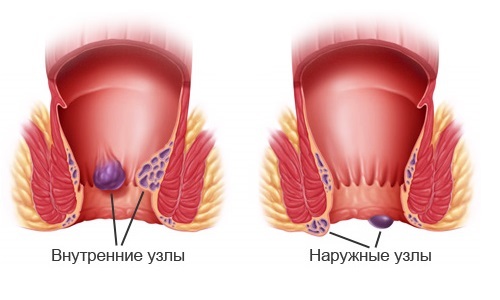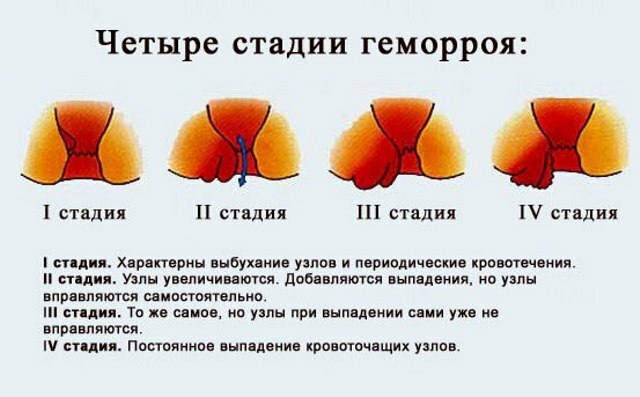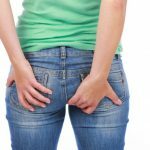Hemorrhoids are a disease that many women feel embarrassed about, considering their problem unworthy of publicity. About 40-60% of women suffer from this disease after 35-40 years. The first symptoms of the disease often appear after childbirth or during pregnancy, after which the hemorrhoids can have a sluggish character with periods of exacerbation and remission. Violation of diet, lifestyle changes and the emergence of other provoking factors can contribute to the transition of the disease into more severe forms, complications that affect the quality of life of a woman. It can be noted that hemorrhoids are often exacerbated with menstruation or on the eve of them. What is the reason for this? How to prevent symptoms?
The causes of
Hemorrhoids are a disease in which two factors play a role:The rectum and the inferiority of her muscular apparatus. The disease manifests itself only in the presence of provocateurs. These include:
- Family predisposition to varicose veins on the lower limbs and other parts of the body. As a rule, in such women, initially the vessels have an inferior valve system, and in the end do not perform an important function - they do not interfere with the reverse blood flow. Also, in such people, the vein wall has a defective structure, as a result of which it is easily extensible, flexible, and returns to its former form poorly. This contributes to the formation of hemorrhoids in the rectum.
- Hypodynamia. Inactive, office lifestyle leads to stagnation of blood in a small pelvis. And if veins have an inferiority of the wall and valve system, then together it provokes constant vasodilation, the formation of serpentine extensions around all organs - the uterus, ovaries and rectum. Regular physical activity, which does not exceed the body's capacity, promotes constant blood circulation, which is the prevention of all forms of varicose veins.
- Overweight, in particular abdominal obesity. The fact is that such deposition of extra pounds contributes to increased intra-abdominal pressure. And this complicates the reverse movement of blood into the lower vena cava. As a result, it is constantly deposited in the organs of the small pelvis and lower limbs.
- Frequent constipation, which forces a person to constantly strain. As a result, the longitudinal muscle of the submucosal layer of the rectum can be injured, especially if it is initially inferior. On the eve of critical days, the likelihood of constipation increases, which is due to certain hormonal changes. As a result, hemorrhoids become more frequent before menstruation.
- The appearance of the disease occurs in many women precisely during pregnancy, especially in its second half. This is the result of the growing uterus squeezing the vessels and organs in their area of location. Elevated intra-abdominal pressure is also created. Together, this complicates the outflow of venous blood from the lower half of the body and provokes the manifestation of hemorrhoids.
- Childbirth is a complex physiological process, sometimes an unbearable burden for the body. Both natural and performed by cesarean section, they can lead to the appearance of the first symptoms of the disease. Subsequently, the exacerbation of hemorrhoids, with menses in particular, will occur more and more often.
- Excessive physical activity also contributes to the appearance of hemorrhoids. It can be like excessive female work, and some sports, for example, bodybuilding. This is due to a constant increase in intra-abdominal pressure during lifting of weights.
Symptoms of hemorrhoids
There are four stages of hemorrhoids. There is also a separate classification for outdoor and indoor. At the last( corresponding to the first and second degree) the nodes can not be determined independently, only certain symptoms are revealed, for example, blood veins in the feces and pain. For external hemorrhoids( combines the third and fourth stage) is characterized by the appearance of "cones" - protrusions of hemorrhoidal veins that have passed through a defect in the longitudinal muscle of the mucous layer of the rectum. Many women note that hemorrhoids get out before the menstruation in most cases of all exacerbations.

Hemorrhoids
The main symptoms of the disease, the detection of which should alert and cause a call to the proctologist:
- The appearance of pain during defecation. As a rule, it occurs for the first time with constipation. In the future, any emptying of the intestines causes discomfort and soreness. If an anal fissure joins to the hemorrhoids, which often happens, the pain occurs even a few hours after the defecation of
- . The appearance of blood in the feces. This may be minor veins, dark or scarlet trickles, and sometimes the appearance of small clots. Blood can appear both during defecation and in a calm state. With chronic hemorrhoids, a disruption of the anal sphincter is observed, which leads eventually to a permanent appearance of feces on the laundry.
- During a period of exacerbation and outside of it, a woman may be bothered by constant itching in the anus, perineum. It is characteristic that hemorrhoids after menstruation manifest similar symptoms. This is due to additional irritation of the skin around the anus with menstrual blood, especially if the woman does not sufficiently conduct hygienic activities with increased sensitivity.
- Also, during the aggravation of the symptoms of the disease, perianal edema, discomfort in the anus can occur.
- Allocation of mucus both during defecation and outside it.
- With expressed hemorrhoids, the appearance of nodes can be detected. In the initial stages they come out during the emptying of the intestine during straining, but they can not be groped because they immediately go back. As the disease progresses, the hemorrhoidal nodes are detected, but they already have to be adjusted independently. In the third and fourth stage, the "bumps" are constantly outside. They can be infringed, which leads to another exacerbation, or they form clots.

Exacerbation of the process during the critical days of
Many women note that the exacerbation of the disease occurs on the eve of critical days. The question arises as to why the hemorrhoids become aggravated with menstruation. Everything is very easy to explain. During menstruation, the influx of venous blood to the organs of the small pelvis increases, and its rheological properties change. All this leads to excessive filling of defective and altered vessels, "bunches of grapes", serpentine extensions are formed.

How to relieve the condition of
For women who are constantly suffering from the manifestations of the disease, you should have at home candles from hemorrhoids, during the months that can also be laid and remove pain, itching, blood. It is desirable that they include the following components: anesthetic, vasoconstrictor, wound-healing agent."Ultraproject", which in addition to the above contains a hormonal agent, which helps to reduce the inflammatory reaction, relieves edema.
If there is nothing at home, you can prepare ice cubes and lay them in the rectum. This method will help reduce pain, for some time to save from unpleasant sensations.
But most importantly during the exacerbation of hemorrhoids - normalize the stool. While the woman will be tormented by constipation, the action of all medicines will last exactly the period of their use.
If the problem is in the irritation of the hemorrhoids with gaskets, it is best to use tampons.
 We recommend that you read an article on pain in the anus during menstruation. From it you will learn about the causes of pain, problems with intestines and gynecological problems, elimination of an unpleasant symptom, as well as preventive measures.
We recommend that you read an article on pain in the anus during menstruation. From it you will learn about the causes of pain, problems with intestines and gynecological problems, elimination of an unpleasant symptom, as well as preventive measures.
Treatment of pathology
Hemorrhoid therapy includes not only medical and surgical treatment, but also lifestyle changes, weight loss and the limitation of other factors that lead to exacerbation of pathology.
Surgical treatment of
Even at the first stage of the disease, minimally invasive modern operations for removal of hemorrhoids are performed, they are not performed during menstruation. Types of interventions:
- Coagulation( cauterization) by infrared waves, electric current.
- Cryotherapy nodes - exposure to liquid nitrogen.
- Sclerotherapy, in which a special preparation is introduced into the modified sites of venous caverns, which contributes to their collapse.
- Ligation - a latex ring is applied to the base of the hemorrhoids, after which the affected areas are rejected for several days.
- Classical hemorrhoidectomy.
As a rule, a combination of techniques is used, sometimes surgical treatment is carried out in several stages.
Medical therapy
 Conservative therapy includes the use of various ointments, suppositories with a combined effect. From herbal preparations, medicines based on sea-buckthorn oil, marigold, propolis are effective. For example, "Olesesin", it also contains benzocaine - an anesthetic component.
Conservative therapy includes the use of various ointments, suppositories with a combined effect. From herbal preparations, medicines based on sea-buckthorn oil, marigold, propolis are effective. For example, "Olesesin", it also contains benzocaine - an anesthetic component.
Synthetic medicines are available in the form of candles and are used for internal units. And ointments are convenient for external hemorrhoids. Popular means are "Relief", "Relief Ultra" and "Relief Advance" - all of them are based on shark liver oil with various additional components. The drug "Neo-anusole" contains zinc and bismuth in the composition, which gives it the property of drying out the wetness on the inflamed nodes. You can use and just heparin, methyluracil ointment or Vishnevsky.
Hemorrhoids are a problem for many women. Episodes of exacerbation often occur during menstruation, which is associated with certain changes in the body these days. Timely detection of the disease, effective treatment will get rid of the ailment for a short time. Often you have to use operational tactics in the fight. But in order to get rid of hemorrhoids forever, you will have to change your lifestyle and re-evaluate your diet and exercise level.
